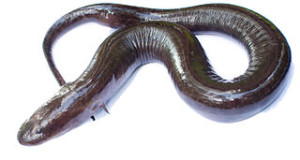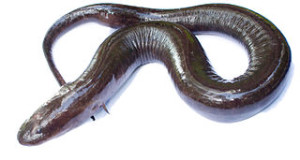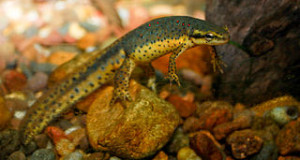Check out: Captive Care of the Mexican Axolotl Ambystoma mexicanum – Part 1, for the first part of this article.
Feeding
 Repto-min, trout chow or salmon chow serves well as a mainstay; alternate this with Hikari Massivore Delight or a pelleted cichlid food, freeze dried prawn, live blackworms, earthworms, minnows, shiners and guppies. Axolotls will also take frozen clams, mussels and similar foods, but marine-derived items should not be used as a major part of the diet.
Repto-min, trout chow or salmon chow serves well as a mainstay; alternate this with Hikari Massivore Delight or a pelleted cichlid food, freeze dried prawn, live blackworms, earthworms, minnows, shiners and guppies. Axolotls will also take frozen clams, mussels and similar foods, but marine-derived items should not be used as a major part of the diet.
Although normally bottom feeders, well-habituated axolotls will rise to the surface to eat, and take readily to hand- feeding. A finger waved before one will be grabbed and “swallowed”.
Finely-chopped blackworms (use a razor) are the best food to start off with when raising larvae; brine shrimp are also accepted, but growth with be faster for those consuming blackworms (and each other!). Be aware that blackworms, even chopped pieces, clump together; larvae may choke trying to take down a large ball. Be sure to swish the worms about the tank, and watch that they do not “find each other” after awhile. A surface worm feeder that releases the worms individually will help relieve this problem. I’ve not been able to induce axolotls under 2 inches in length to accept Repto-min or other dry foods, but others report success with very small individuals.
Social Groups
While not overly aggressive toward each other when un-crowded, the feeding of live food seems to stimulate a near frenzy, during which animals may bite the gills and toes of their tank-mates. Generally these grow back without problems, but a treatment with Aquarium Pharmaceuticals Stresscoat is a useful safety measure.
Axolotls housed together should be nearly the same size – even a difference of 25% is too great, as the larger animal will eventually bite off the gills and limbs of the smaller, possibly killing it. Feeding injuries among similarly-sized animals are less severe – the loss of a toe or gill tip.
Losses are usually high when young animals are reared together, but can be lessened somewhat by the provision of dense cover (please see “Physical Environment”, above).
Captive Longevity
 Captive longevity approaches 25 years. Animals in my collection are still breeding at age 17.
Captive longevity approaches 25 years. Animals in my collection are still breeding at age 17.
Handling
It is best to usher an axolotl into a plastic container, as they may damage their delicate skins when thrashing about in a nylon net. Axolotls may also be picked up by hand, but use caution as they tend to lie very still and then suddenly explode, and can easily propel themselves to the floor. Handle only when necessary to move or examine an animal, and use wet hands and great care as the skin is quite injury-prone.
Miscellaneous
The axolotl’s long history as a laboratory animal has given rise to a wide variety of attractive color phases, including leucistic, black, albino, piebald and others. The genetics of color inheritance in this species is quite interesting, and seems not to follow the “normal” rules…at least not as I learned them! Recently, bio-engineered axolotls that glow fluorescent green have appeared in the trade.
Rearing axolotls in the lab differs in some respects from home care, but much of value is contained in the protocols of institutions maintaining large research colonies. You can read about how it’s done at laboratories and universities all over the world at:
 That Reptile Blog – Reptile, Amphibian and Exotic Pet Care and Information
That Reptile Blog – Reptile, Amphibian and Exotic Pet Care and Information




were cn i get1
Hello, Frank Indiviglio here.
Thanks for your interest in our blog.
We often have axolotls in our store in Lancaster, PA. If you are not in the area, you might try local reptile shows (most states feature several each year; locations are usually posted on line). Salamander breeders sometimes advertise on line, but axolotls, except for very small ones, do not ship well and are best purchased locally.
Good luck and please keep me posted.
Best regards, Frank Indiviglio.
Thanks for such a nice article. It gives very good information on an animal I have just learned about but am fully enchanted with! Hoping to be able to find a local breeder here in Oregon.
Regards,
Joann
Hello Joann, Frank Indiviglio here.
How nice that my first comment of the New Year is such a pleasant one…thanks very much!
“Enchant” is a good word – axolotls do have a way of doing that, even as regards folks who never dreamed of keeping amphibians. About 10 years ago they exploded in popularity in Japan – it really was a national phenomenon. They were in every public aquarium, pet store, in advertisements and so on, and some useful husbandry information was generated by all the interest.
I can put you in touch with a good private breeder in PA if you cannot find a local source…eggs and young animals ship well, but adults do not.
Good luck and please keep me posted.
Best wishes for a happy, healthy New Year, Frank Indiviglio.
This Website Gives the basic rules, and if you have a worrie it basically tells you all you need to know …. apart from what foods Ambystoma’s and Axolotl’s need :S But this is very helpful for me and could be for you! cheek it out you might have a different opinon to me i think it’s friendly, it’s helpful, it’s useful and above all IT’S ONE OF A KIND!!!
Hello Kelsey-may, Frank Indiviglio here.
Thanks so much for taking the time to write in with your kind comment. I look forward to hearing from you in the future,
Good luck, enjoy and please keep me posted.
Best regards, Frank Indiviglio.
do they go on land also?do they like it on land?how many sould i get?
Thank you for such a helpful article. My pair of albino axies presented me with lots of eggs 5 days ago and I have been trying to find out how to raise them. I think I know how to do it now.
Thanks again
Hello Sandra
Thanks for the kind words.
Care of the larvae differs from that of adults. Have you also seen this article on hatching eggs and feeding the young? They need live food for the first few weeks (although some folks claim success with dry foods earlier), after which they can be switched to pellets. They are also highly cannibalistic.
Please let me know if you need any further information. Good luck, enjoy and please keep me posted as things progress.
Best regards, Frank Indiviglio.